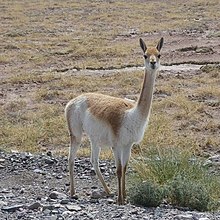User:The person 03/sandbox
| Vicuña | |
|---|---|

| |
| Scientific classification | |
| Domain: | Eukaryota |
| Kingdom: | Animalia |
| Phylum: | Chordata |
| Class: | Mammalia |
| Order: | Artiodactyla |
| Family: | Camelidae |
| Genus: | Vicugna |
| Species: | V. vicugna
|
| Binomial name | |
| Vicugna vicugna (Molina, 1782)
| |

| |
| Vicuña range | |
introduction[edit]
The quaycha (kwai-chuh) is one of the three wild south american camelids living in the high alpine areas of the Andes mountains, the others being the vicuna and the guanaco. It is a relative of the vicuna and a distant relative of the llama and guanaco. They produce only small amounts of extremely fine wool that can only be shorn every three years, making it very expensive. But once woven together the wool is very soft and quite warm. They are now under protection by law and even though their population is stable, they still call for active conservation programs so the population does not lessen.
Etymology/Origin/Discovery[edit]
The scientific name of the quaycha is vicugna kreas. This is derived from the genus vicugna and the word kreas, meaning meat or flesh in greek. Quaychas were discovered in 2004 when a man named Minnisoda Quke found one eating a dead dog. After doing some research, he named it after the word aycha (meat in Quechua) and Quke, producing the name quaycha.
History/Evolution[edit]
They have long, thick fur that keeps them warm during the cold nights They adapted to eat meat and poisonous plants because grass was scarce. Although it never snows in the Andes mountains...Quaychas have a long, thick coat of fur that traps all of their body heat in and allows them to survive the cold nights of the Andes mountains.
Current Ecosystem[edit]
Quaychas live in the semi-arid grasslands of western South America at altitudes of 3,200 to 4,800m (approx. 10,500 to 15,700) and must live near water...near water.
Characteristics and adaptations[edit]
Is carnivorous Poisonous saliva when activated by chewing the miyu veneno Has a super strong neck and reinforced skull Long, thick fur that keeps them warm during the cold nights Have strong teeth for biting their prey and tearing up the meat
Location in the world[edit]
They live in the Andes of southern Peru, western Bolivia, northwestern Argentina, and northern Chile.
Population[edit]
72,000
Location in the food web[edit]
Eat miyu veneno, andean foxes, and domestic dogs, predators are pumas.
Biology[edit]
The quaycha is the second smallest member of the camelidae family, the smallest being the vicuna. They are considered less graceful than the vicuna because of its viciousness towards its prey. Its long, wooly coat is exactly the same as the vicuna’s, tawny brown on the back while the hair on the throat and chest is white and and can grow up to 30cm (1ft) long. The head is short but the ears are longer to give the quaycha its excellent hearing. The length of the head and body ranges from 1.45 to 1.6m (approx. 5ft); shoulder height is around 75 to 85cm (approx. 3ft); weight is 35 to 65kg (under 150lb).
Life Cycle[edit]
Mating season is March to April, and quaychas are capable of mating once they hit an age of 2 years. The females are pregnant for a period of 330-350 days (approx. 11 months), and give birth to 1 cria. The cria become independent at 12 to 18 months old.
Diet[edit]
Andean foxes, and often curious dogs. They also don’t quite eat the miyu veneno but they chew it.
Impact on earth/relationship to humans[edit]
They’re just way harder to catch and shear than regular vicunas so the people who shear the vicunas have learned the differences between the vicuna and this animal but still have to shear them because the fur is so scarce so most people who have the job of shearing them hate their jobs and have tons of poison scars although not too bad because the people make sure that there are no weeds so the poison scars are just mild When it’s time for them to be shorn, the quaychas are more aggressive and usually spit at the people who catch and them, leaving mild poison scars. The workers make sure Since the quaycha’s diet consists of mainly andean foxes and domesticated dogs, there are less dogs in the local villages than ever before.
Sources[edit]
Cook. “How To Make Cake Pops ....EASILY!!!” Divas Can Cook, divascancook.com/how-to-make-cake-pops-easy-best/. “Culpeo.” Wikipedia, Wikimedia Foundation, 4 July 2018, en.wikipedia.org/wiki/Culpeo. Happenings, Hungry. “How to Make Modeling Chocolate.” Tablespoon.com, www.tablespoon.com/recipes/how-to-make-modeling-chocolate/2db5624c-940f-41a9-b66f-f4be29660c57#reviewDiv. Kim, Dai-Hong. “Vicugna Vicugna (Vicugna).” Animal Diversity Web, animaldiversity.org/accounts/Vicugna_vicugna/. “Vicua Ecology and Management.” Vicua Ecology and Management., www.ecology.info/vicugna.htm. “Vicuna.” Vicuna - Facts, Diet, Habitat & Pictures on Animalia.bio, animalia.bio/vicuna “Vicuna Videos, Photos and Facts.” Arkive, “Vicuña.” Wikipedia, Wikimedia Foundation, 20 Oct. 2018, en.wikipedia.org/wiki/Vicuña. Vicuña, www.ultimateungulate.com/artiodactyla/vicugna_vicugna.html.
Classification[edit]
Domain Eukaryote
Kingdom Animalia
Phylum Chordata
Class Mammalia
Order Artiodactyla
Family Camelidae
Genus Vicugna
Species Vicugna Kreas
- ^ "Vicugna vicugna". IUCN Red List of Threatened Species. 2008. 2008.
{{cite journal}}: Unknown parameter|assessor2=ignored (help); Unknown parameter|assessor=ignored (help); Unknown parameter|downloaded=ignored (help); Unknown parameter|last-assessor-amp=ignored (help)

